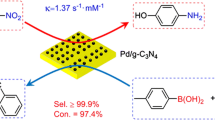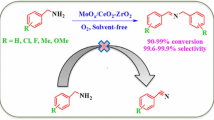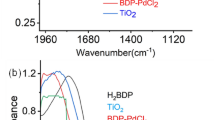Abstract
Palladium nanoparticles (Pd NPs) supported on a cerium-based metal–organic framework Ce-MOF-801 (Pd/Ce-MOF-801) was prepared using an incipient wetness impregnation strategy. Multiple analytical techniques were used to investigate the physicochemical properties of Pd/Ce-MOF-801. Afterwards, its catalytic efficiency in the Suzuki-Miyaura cross-coupling reaction between different haloarenes and phenylboronic acid was assessed. The developed Pd/Ce-MOF-801 displayed a high catalytic performance at 318 K and in the presence of K2CO3 as well as aqueous ethanol (as a solvent), much superior to Pd/Ce-BTC as well as the analogs reported in the literature by comprehensively comparing the catalytic activity and the relationship between reaction temperature and catalyst dosage. Moreover, the catalyst exhibited negligible Pd species leaching and was capable of being recycled in eight successive runs without any decay in reactivity. Such protocol has the advantages of ambient reaction conditions and tolerance to various substrates with various functional groups.
Graphical Abstract







Similar content being viewed by others
References
Wang J, Liu CF, Zheng Q et al (2020) C-H functionalization of biaryl compounds. Eur J Org Chem 2020:3737–3765
Jain ZJ, Gide PS, Kankate RS (2017) Biphenyls and their derivatives as synthetically and pharmacologically important aromatic structural moieties. Arab J Chem 10:S2051–S2066
Felpin FX, Sengupta S (2019) Biaryl synthesis with arenediazonium salts: cross-coupling, CH-arylation and annulation reactions. Chem Soc Rev 48:1150–1193
Wu XF, Anbarasan P, Neumann H et al (2010) From noble metal to nobel prize: palladium-catalyzed coupling reactions as key methods in organic synthesis. Angew Chem Int Ed 49:9047–9050
Balanta A, Godard C, Claver C (2011) Pd nanoparticles for C-C coupling reactions. Chem Soc Rev 40:4973–4985
Maluenda I, Navarro O (2015) Recent developments in the Suzuki-Miyaura reaction: 2010–2014. Molecules 20:7528–7557
Das P, Linert W (2016) Schiff base-derived homogeneous and heterogeneous palladium catalysts for the Suzuki-Miyaura reaction. Coord Chem Rev 311:1–23
Bugday N, Altin S, Yasar S (2021) Palladium nanoparticle supported on nitrogen-doped porous carbon: investigation of structural properties and catalytic activity on Suzuki-Miyaura reactions. Appl Organomet Chem 35:1–23
Veerabagu U, Chen ZB, Xiang J et al (2021) Novel cigarette butts-derived porous carbon-based catalyst for highly efficient Suzuki-Miyaura cross-coupling reaction. J Environ Chem Eng 9:1–10
Zhang L, Feng C, Gao ST et al (2015) Palladium nanoparticle supported on metal-organic framework derived N-decorated nanoporous carbon as an efficient catalyst for the Suzuki coupling reaction. Catal Commun 61:21–25
Dong WH, Zhang L, Wang CH et al (2016) Palladium nanoparticles embedded in metal-organic framework derived porous carbon: synthesis and application for efficient Suzuki-Miyaura coupling reactions. RSC Adv 6:37118–37123
Zhang L, Dong WH, Shang NZ et al (2016) N-Doped porous carbon supported palladium nanoparticles as a highly efficient and recyclable catalyst for the Suzuki coupling reaction. Chin Chem Lett 27:149–154
Shang NZ, Feng C, Zhang HY et al (2013) Suzuki-Miyaura reaction catalyzed by graphene oxide supported palladium nanoparticles. Catal Commun 40:111–115
Shang NZ, Gao ST, Feng C et al (2013) Graphene oxide supported N-heterocyclic carbene-palladium as a novel catalyst for the Suzuki-Miyaura reaction. RSC Adv 3:21863–21868
Gao ST, Shang NZ, Feng C et al (2014) Graphene oxide-palladium modified Ag-AgBr: a visible-light-responsive photocatalyst for the Suzuki coupling reaction. RSC Adv 4:39242–39247
Polshettiwar V, Len C, Fihri A (2009) Silica-supported palladium: sustainable catalysts for cross-coupling reactions. Coord Chem Rev 253:2599–2626
Durap F, Rakap M, Aydemir M et al (2010) Room temperature aerobic Suzuki cross-coupling reactions in DMF/water mixture using zeolite confined palladium (0) nanoclusters as efficient and recyclable catalyst. Appl Catal A 382:339–344
Bankar DB, Hawaldar RR, Arbuj SS et al (2020) Palladium loaded on ZnO nanoparticles: synthesis, characterization and application as heterogeneous catalyst for Suzuki-Miyaura cross-coupling reactions under ambient and ligand-free conditions. Mater Chem Phys 243:1–10
Akkoc M, Bugday N, Altin S et al (2022) Highly active Fe3O4@SBA-15@NHC-Pd catalyst for Suzuki-Miyaura cross-coupling reaction. Catal Lett 152:1621–1638
Ziarani GM, Rohani S, Ziarati A et al (2018) Applications of SBA-15 supported Pd metal catalysts as nanoreactors in C-C coupling reactions. RSC Adv 8:41048–41100
Sargin I, Baran T, Arslan G (2020) Environmental remediation by chitosan-carbon nanotube supported palladium nanoparticles: conversion of toxic nitroarenes into aromatic amines, degradation of dye pollutants and green synthesis of biaryls. Sep Purif Technol 247:1–10
Sadjadi S, Heravi MM, Raja M (2018) Combination of carbon nanotube and cyclodextrin nanosponge chemistry to develop a heterogeneous Pd-based catalyst for ligand and copper free C-C coupling reactions. Carbohyd Polym 185:48–55
Montini T, Melchionna M, Monai M et al (2016) Fundamentals and catalytic applications of CeO2-based materials. Chem Rev 116:5987–6041
Chen XD, Su X, Liang BL et al (2016) Identification of relevant active sites and a mechanism study for reverse water gas shift reaction over Pt/CeO2 catalysts. J Energy Chem 25:1051–1057
Wang PF, Wang J, Shi J et al (2020) Low content of samarium doped CeO2 oxide catalysts derived from metal organic framework precursor for toluene oxidation. Mol Catal 492:1–10
Zhang S, Li J, Gao W et al (2015) Insights into the effects of surface properties of oxides on the catalytic activity of Pd for C-C coupling reactions. Nanoscale 7:3016–3021
Yang QH, Xu Q, Jiang HL (2017) Metal-organic frameworks meet metal nanoparticles: synergistic effect for enhanced catalysis. Chem Soc Rev 46:4774–4808
Evans JD, Garai B, Reinsch H et al (2019) Metal-organic frameworks in Germany: from synthesis to function. Coord Chem Rev 380:378–418
Razavi SAA, Morsali A (2019) Linker functionalized metal-organic frameworks. Coord Chem Rev 399:213023–213079
Kargar PG, Aryanejad S, Bagherzade G (2020) Simple synthesis of the novel Cu-MOF catalysts for the selective alcohol oxidation and the oxidative cross-coupling of amines and alcohols. Appl Organomet Chem 34:1–12
Carson F, Pascanu V, Gomez AB et al (2015) Influence of the base on Pd@MIL-101-NH2 (Cr) as catalyst for the Suzuki-Miyaura cross-coupling reaction. Chem Eur J 21:10896–10902
Veisi H, Abrifam M, Kamangar SA et al (2021) Pd immobilization biguanidine modified Zr-UiO-66 MOF as a reusable heterogeneous catalyst in Suzuki-Miyaura coupling. Sci Rep 11:1–14
Dong DP, Li ZH, Liu DD et al (2018) Postsynthetic modification of single Pd sites into uncoordinated polypyridine groups of a MOF as the highly efficient catalyst for Heck and Suzuki reactions. New J Chem 42:9317–9323
Wang BQ, Liu WX, Zhang WN et al (2017) Nanoparticles@nanoscale metal-organic framework composites as highly efficient heterogeneous catalysts for size- and shape-selective reactions. Nano Res 10:3826–3835
Zhang WL, Shi WX, Ji WL et al (2020) Microenvironment of MOF channel coordination with Pt NPs for selective hydrogenation of unsaturated aldehydes. ACS Catal 10:5805–5813
Treesa GSS, Saranya S, Meera G et al (2020) Recent advances and perspectives in the silver-catalyzed multi-component reactions. Curr Org Chem 24:291–313
Lammert M, Wharmby MT, Smolders S et al (2015) Cerium-based metal organic frameworks with UiO-66 architecture: synthesis, properties and redox catalytic activity. Chem Commun 51:12578–12581
Rojas-Buzo S, Concepcion P, Olloqui-Sariego JL et al (2021) Metalloenzyme-inspired Ce-MOF catalyst for oxidative halogenation reactions. ACS Appl Mater Interfaces 13:31021–31030
Dai S, Nouar F, Zhang SJ et al (2021) One-step room-temperature synthesis of metal (IV) carboxylate metal-organic frameworks. Angew Chem Int Ed 60:4282–4288
Eskandari S, Tate G, Leaphart NR et al (2018) Nanoparticle synthesis via electrostatic adsorption using incipient wetness impregnation. ACS Catal 8:10383–10391
Zhang HF, Qiu JJ, Yan BC et al (2021) Regulation of Ce (III)/Ce (IV) ratio of cerium oxide for antibacterial application. iScience 24:1–23
Dutta P, Pal S, Seehra M et al (2006) Concentration of Ce3+ and oxygen vacancies in cerium oxide nanoparticles. Chem Mater 18:5144–5146
Kar AK, Kaur SP, Kumar TJD et al (2020) Efficient hydrogenolysis of aryl ethers over Ce-MOF supported Pd NPs under mild conditions: mechanistic insight using density functional theoretical calculations. Catal Sci Technol 10:6892–6901
Sun WJ, Li XM, Sun C et al (2019) Insights into the pyrolysis processes of Ce-MOFs for preparing highly active catalysts of toluene combustion. Catalysts 9:1–15
Zhang Q, Zhao XR, Duan LB et al (2020) Controlling oxygen vacancies and enhanced visible light photocatalysis of CeO2/ZnO nanocomposites. J Photoch Photobiol A 392:1–10
Erunal E (2021) Estimation of the number of active sites through kinetic analysis on MWCNT-supported nanocatalysts. Int J Chem Kinet 53:954–963
Wang YG, Mei DH, Li J et al (2013) DFT+U study on the localized electronic states and their potential role during H2O dissociation and CO oxidation processes on CeO2 (111) surface. J Phys Chem C 117:23082–23089
Li YL, Zhang ZQ, Fan T et al (2016) Magnetic core-shell to yolk-shell structures in palladium-catalyzed Suzuki-Miyaura reactions: heterogeneous versus homogeneous nature. ChemPlusChem 81:564–573
Wang ZJ, Lv JJ, Feng JJ et al (2015) Enhanced catalytic performance of Pd-Pt nanodendrites for ligand-free Suzuki cross-coupling reactions. RSC Adv 5:28467–28473
Srimani D, Sawoo S, Sarkar A (2007) Convenient synthesis of palladium nanoparticles and catalysis of Hiyama coupling reaction in water. Org Lett 9:3639–3642
Ueura K, Satoh T, Miura M (2005) Rhodium-catalyzed arylation using arylboron compounds: efficient coupling with aryl halides and unexpected multiple arylation of benzonitrile. Org Lett 7:2229–2231
Acknowledgements
We thank the financial support from the National Natural Science Foundation of China (Grant No. 21576243), and the Natural Science Foundation of Zhejiang Province (Grant No. LY18B060006).
Author information
Authors and Affiliations
Contributions
WL: investigation, methodology, writing—original draft. YS: methodology. LW: methodology. NL: methodology. YF: writing—original draft. De-LiC: writing—original draft. WZ: project administration. FZ: conceptualization, project administration, supervision, Writing—review & editing.
Corresponding author
Ethics declarations
Conflict of interest
The authors declare that they have no known competing financial interests.
Additional information
Publisher's Note
Springer Nature remains neutral with regard to jurisdictional claims in published maps and institutional affiliations.
Supplementary Information
Below is the link to the electronic supplementary material.
Rights and permissions
Springer Nature or its licensor holds exclusive rights to this article under a publishing agreement with the author(s) or other rightsholder(s); author self-archiving of the accepted manuscript version of this article is solely governed by the terms of such publishing agreement and applicable law.
About this article
Cite this article
Lin, W., Song, Y., Wang, L. et al. Palladium Nanoparticles Supported on Ce-MOF-801 as Highly Efficient and Stable Heterogeneous Catalysts for Suzuki-Miyaura Coupling Reactions. Catal Lett 153, 2368–2377 (2023). https://doi.org/10.1007/s10562-022-04163-4
Received:
Accepted:
Published:
Issue Date:
DOI: https://doi.org/10.1007/s10562-022-04163-4




